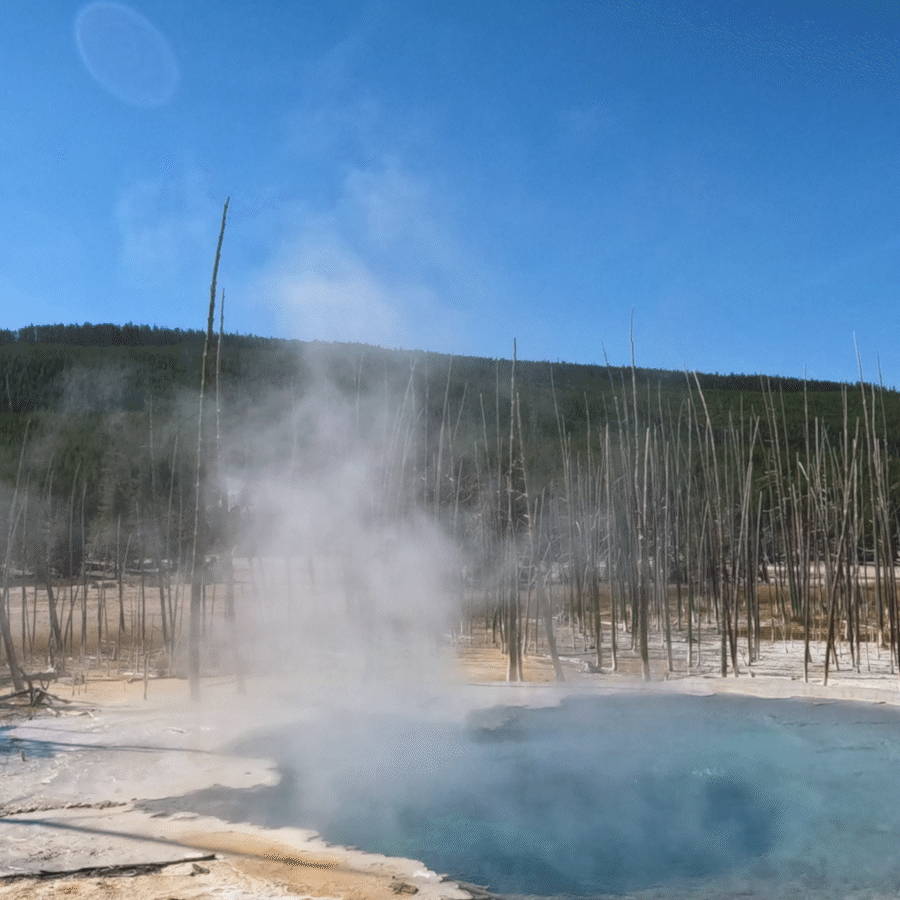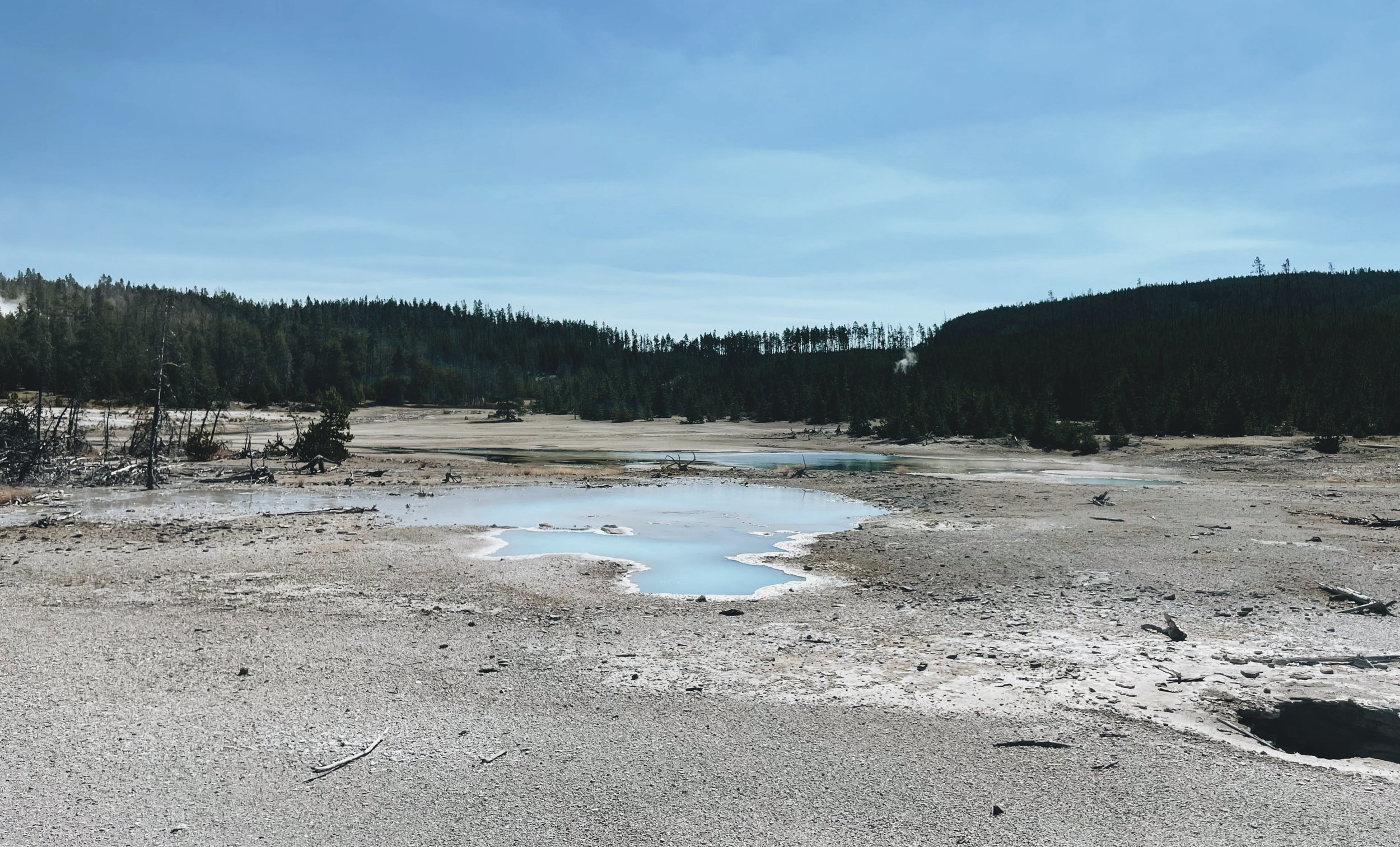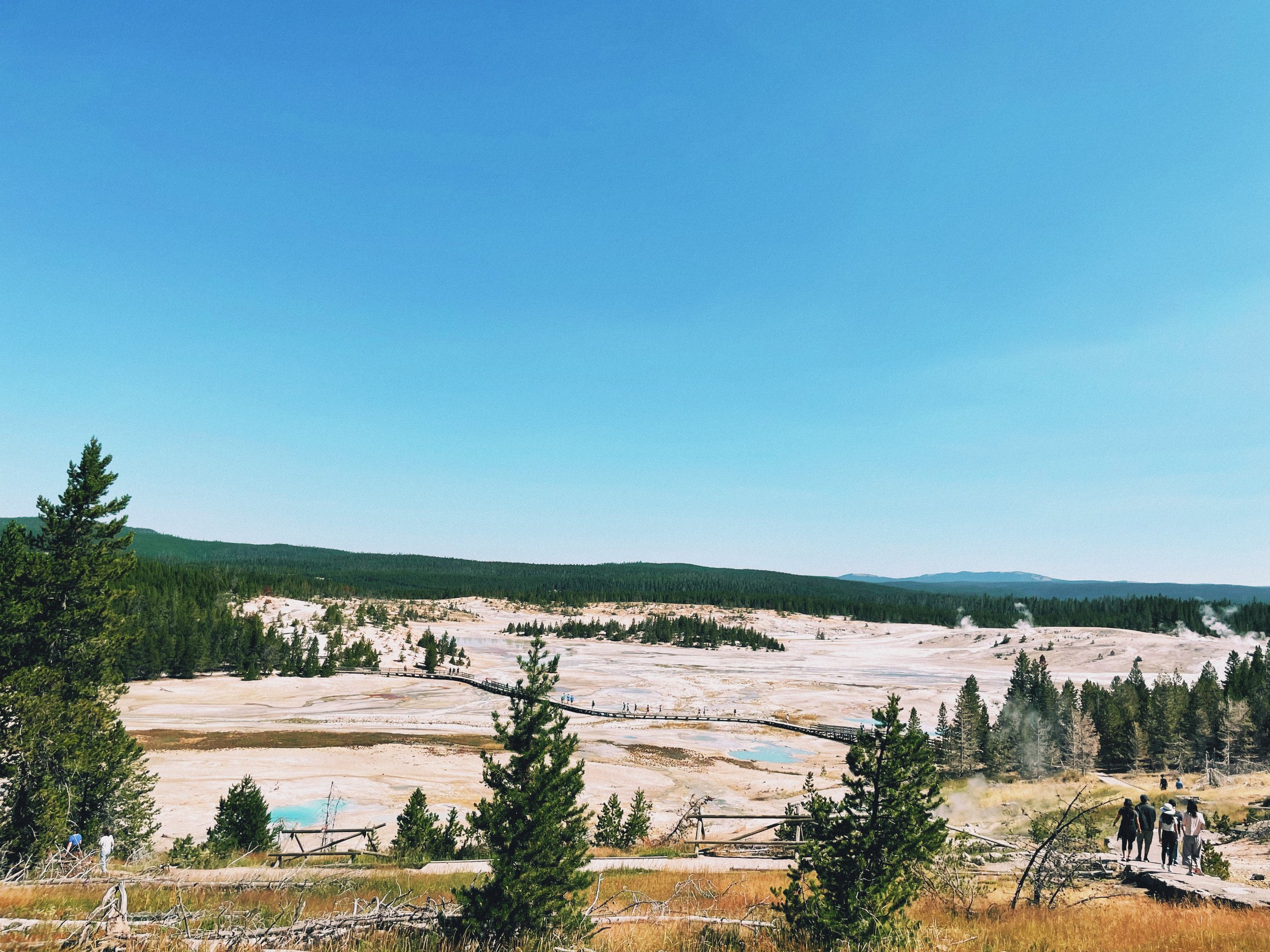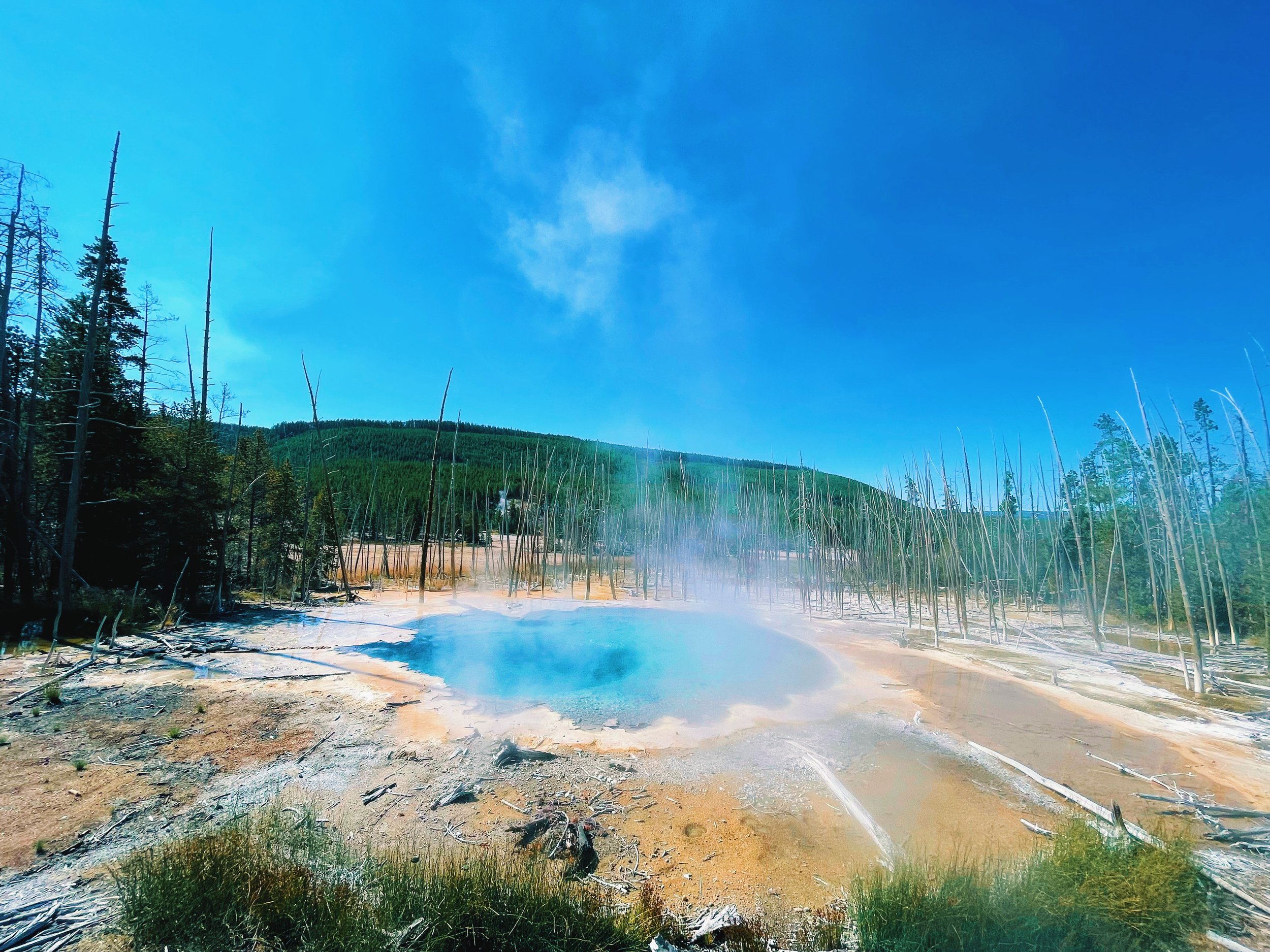Discover Yellowstone’s Norris Geyser Basin: A Journey Through Geothermal Wonders.
Welcome to the heart of Yellowstone's geothermal wonders — Norris Geyser Basin. As one of Yellowstone National Park's most dynamic and hottest thermal areas, Norris captivates visitors with its ever-changing geysers, hot springs, and fumarole landscape. Norris Geyser Basin is a testament to the Earth's raw power, showcasing the incredible geological forces shaping this iconic destination. Join us on a journey into the world of Norris, where the ground steams, colors dance, and geysers paint the sky with their powerful eruptions.
What You Will Learn in This Guide:
Key geothermal features of Norris Geyser Basin
Highlights of the Porcelain Basin and Back Basin
Safety tips for visiting this hot geothermal area
Practical visitor information and FAQs
Exploring Norris Geyser Basin: Yellowstone's Geothermal Wonderland.
This basin is divided into two sections — the Porcelain Basin and the Back Basin, each offering unique features and attractions. The Porcelain Basin is known for its stark, white landscape, while the Back Basin features a variety of geysers and hot springs. Together, they offer a rich tapestry of geothermal features at Norris Geyser Basin.
Top Geothermal Features of Norris Geyser Basin in Yellowstone:
Geysers: Home to several geysers, including the famous Steamboat Geyser, the world's tallest active geyser. Geysers are characterized by intermittent eruptions of hot water and steam from underground.
Hot Springs: The basin features numerous hot springs, where geothermally heated water rises to the surface. Vibrant colors in the hot springs often result from thermophiles, heat-loving microorganisms that thrive in the warm water.
Fumaroles: Openings in the Earth's crust that emit steam and gases, with a high concentration in Norris, creating an otherworldly atmosphere.
Mud Pots: Bubbling, churning mud results from the interaction between water, gases, and volcanic rock, though less prevalent in Norris than other Yellowstone areas.
Steam Vents: Areas where steam escapes directly from the ground, often creating a hissing sound and contributing to the overall geothermal activity in the basin.
Porcelain Basin: The Stark and White Geothermal Marvel of Yellowstone.
Porcelain Basin is a distinct area within Norris Geyser Basin, known for its stark, white landscape and a concentration of geothermal features. The white appearance is primarily due to the sinter, a silica deposit formed when hot water containing dissolved silica emerges and cools, precipitating the silica onto the surface. This reflective property gives the landscape a bright and dazzling appearance.
Must-See Geothermal Attractions in Porcelain Basin, Yellowstone:
Emerald Spring in Norris Geyser Basin.
Whirligig Geyser: Known for its frequent and lively eruptions with a swirling motion.
Constant Geyser: Provides a consistent display of thermal activity with its continuous eruptions.
Minute Geyser: Erupts at regular intervals, creating a captivating display.
New Crater Geyser: Exhibits frequent and unpredictable eruptions.
Ledge Geyser: Produces eruptions from a ledge, adding to the overall spectacle.
Black Growler Steam Vent: Emits constant steam, contributing to the otherworldly atmosphere.
Emerald Spring: Known for its striking green-blue waters, though primarily associated with the Back Basin.
Back Basin: Explore the Dynamic Geothermal Landscape of Yellowstone.
Looking down on to Back Basin
The Back Basin is known for its dynamic and diverse geothermal features, which are more prominent in scope than the Porcelain Basin.
Top Attractions in Back Basin, Yellowstone's Geothermal Hotspot:
Cistern Spring
Steamboat Geyser: The world's tallest active geyser, capable of shooting water over 300 feet into the air.
Norris Geyser: Known for its frequent eruptions and dynamic nature.
Echinus Geyser: Features a colorful and intricate cone with bursts of water and steam.
Cistern Spring: A hot spring with deep blue color and intricate silica formations.
Pearl Geyser: Often accompanied by colorful and reflective pools.
Vixen Geyser: Noted for vibrant orange mineral deposits and periodic eruptions.
Porkchop Geyser: Features a distinctive flat-shaped cone.
Crater Spring: Displays various colors created by thermophiles.
Black Growler Steam Vent: Contributes to the geothermal activity with a constant steam flow.
Safety Tips for Visiting Yellowstone’s Norris Geyser Basin.
Norris Geyser Basin is a hot area — super hot! To ensure your safety:
Stay on Designated Paths and Boardwalks: Protect yourself and the fragile geothermal features.
Do Not Touch or Disturb the Features: Avoid contact with the thermal features to prevent burns and damage.
Keep a Safe Distance: Boiling water and steam can cause severe burns, making the ground unstable.
Geothermal Temperature Ranges in Norris Geyser Basin:
Read the below if you can’t figure it out from the boiling water and the intense steam.
Geysers: Water can reach temperatures near or above the boiling point, typically 160°F (71°C) to 200°F (93°C) or higher.
Hot Springs: Temperatures range from 130°F (54°C) to 199°F (93°C) or more.
Mud Pots: Temperatures range from 140°F (60°C) to 200°F (93°C) or higher.
Fumaroles and Steam Vents: Emit steam and gases exceeding 199°F (93°C).
Experience the Otherworldly Geothermal Wonders of Norris Geyser Basin.
Walking through Norris Geyser Basin can evoke a sense of stepping onto another planet. The boardwalks guide you through a surreal and awe-inspiring landscape. Steam rises from countless vents and fumaroles, creating an extraterrestrial atmosphere. Hot springs with vibrant hues and intricate silica formations paint an alien tableau against the stark white backdrop. The air carries the distinct scent of sulfur, immersing you in a unique sensory experience. This is why Norris Geyser Basin is one of the top eight must-sees in Yellowstone.
Practical Visitor Information and FAQs.
Best Time to Visit: Summer and early fall offer the best weather and access.
How to Get There: Norris Geyser Basin is located in Yellowstone National Park, accessible by car via the Grand Loop Road.
Preparations: Wear comfortable walking shoes, bring water, and prepare for changing weather conditions.
FAQs:
Q: Can I visit Norris Geyser Basin in winter?
A: Winter access is limited and typically requires snowmobiles or guided tours due to heavy snowfall.
Q: Are pets allowed in Norris Geyser Basin?
A: Pets are not allowed on the boardwalks or trails for safety and preservation reasons.
Q: How long should I plan to visit Norris Geyser Basin?
A: Plan for at least 1-2 hours to fully explore both the Porcelain Basin and Back Basin.
The Importance of Staying on the Boardwalks.
During my visit to Midway Geyser Basin, I witnessed someone touch the Grand Prismatic Spring, a big no-no. Here’s why it’s crucial to stay on the boardwalks and avoid touching any of the geothermal features:
Safety Risks: The water in the hot springs can reach extremely high temperatures, often exceeding 160°F (70°C). Touching the water can result in severe burns or other injuries.
Preservation of Natural Features: The geothermal features are delicate and can be easily damaged by human interference. Oils and contaminants from our skin can disrupt the fragile ecosystems within these hot springs.
Legal Consequences: Touching or entering the geothermal features in Yellowstone National Park is illegal. Violating these rules can result in hefty fines and other legal actions.
Protecting Wildlife: The geothermal areas are home to unique microorganisms and wildlife. Interference can harm these species and disrupt their habitats.
By staying on the boardwalks and respecting the natural environment, we help preserve these incredible features for future generations.
Why Midway Geyser Basin is a Top Yellowstone Destination
Midway Geyser Basin is a must-see destination, primarily for its captivating centerpiece, the Grand Prismatic Spring. The vibrant blue hues, surrounded by orange, green, and yellow rings, create a visually stunning natural masterpiece.
The basin also boasts unique geothermal features like Excelsior Geyser, Turquoise Pool, and Opal Pool, each offering distinct colors and shapes. Exploring the basin via well-maintained boardwalks provides a safe and immersive experience, allowing visitors to witness active geothermal activity, from bubbling hot springs to steaming vents.
There is just nothing like it anywhere else in the world. The combination of striking natural beauty, fascinating geothermal features, and easy accessibility makes Midway Geyser Basin a top destination for anyone visiting Yellowstone National Park.
Additional Tips for Visiting Midway Geyser Basin.
Best Time to Visit: Early morning or late afternoon for fewer crowds and better lighting for photography.
What to Bring: Comfortable walking shoes, a camera, sunscreen, and water.
Safety Tips: Always stay on the boardwalks to protect yourself and the delicate geothermal features.
Check Out Our Other Blogs and YouTube Videos on Yellowstone.
For more detailed information on each attraction and additional tips for planning your trip, check out our other blogs on Yellowstone:
Field Notes: Exploring the Wonders of West Thumb Geyser Basin in Yellowstone.
Your Ultimate Guide to the Top Ten Must-Sees at Yellowstone National Park.
Passport To Your National Parks: A Traveler's Must-Have for National Parks
YouTube: Take a walk with us through Yellowstone's Midway Geyser Basin - home to Grand Prismatic Spring.







